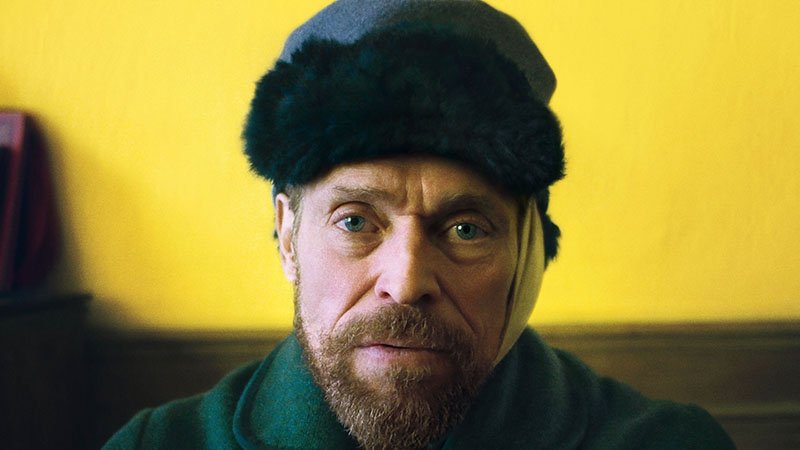AT ETERNITY’S GATE
CBS Films
Reviewed by: Harvey Karten
Director: Julian Schnabel
Screenwriter: Jean-Claude Carriere, Louise Kugelberg, Julian Schnabel
Cast: Willem Dafoe, Oscar Isaac, Mathieu Amalric, Mads Mikkelsen, Emmanuelle Seigner, Amira Casar, Niels Arestrup
Screened at: Bryant Park Hotel, NYC, 11/10/18
Opens: November 16, 2018
What is the principal selling point made by real estate agents when they try to sell pricey apartments? You’d probably think it was the space that the dwelling affords, though agents try to get away with calling a space that looks like your closet “cozy.” A most important selling point aside from the quality of the neighborhood and its schools is the amount of light the occupants might enjoy for most of the day. If you’re not spenders your winters in Iceland, you would indeed be tempted to loosen your wallet if your digs offered brilliant sunlight.
And sunlight is probably the key word when you think of Vincent Van Gogh. He is portrayed by Willem Dafoe as the director’s accurate image of the artist, the movie itself often an impressionistic look at the post-impressionist painter. (By post-impressionism is meant the attempt by artists of the late 19th and early 20th century to opt for color, line and form rather than the naturalism of the impressionists, emphasizing the artist’s emotional responses–a new style that would lead shortly to expressionism.)
Rather than a biopic, Schnable’s “Eternity’s Gate” is based largely on the painter’s letters, and much of the content of the movie is fictional, but the basic look of Van Gogh’s last years showcases his poverty from the inability to sell his paintings. At one point he tells a priest that he may have been born too early, that like Jesus, nobody talked about him during his lifetime.
As played by Willem Dafoe who is made up in the image of the painter, Van Gogh has psychological problems which we today all know because the best known fact about the painter’s character is that in a rage he sliced off part of his ear and presented it to a woman. Though born into an upper-middle class Dutch family, he relies on his brother Theo (Rupert Friend) for support of 250 francs a month, which allows him a decent enough way to live while he does the only thing he says that he knows how to do: paint. Whether he is hallucinatory in several parts of the movie, whether Schnabel creates scenes from the director’s own imagination, or whether these scenes actually occurred, is anybody’s guess. For example, at one point he is out in nature on a bright day—the sort of day that keeps him within the limits of sanity. He is attacked by a class of school children who ignore their teacher and run to him shouting “a painter, a painter,” as though they had just discovered a Ben and Jerry’s out in nowhere. They upset his paintings and cause Van Gogh to shout “Get out of here,” which is not unlike what occurs later as some kids of about twelve years of age throw rocks at his head and even later when he is threatened by a couple young people with guns.
What comes to mind at some point in the story is whether mental instability is the sina qua non of great artistry. Would Van Gogh have been a greater painter if he were completely normal like some organization man who decades later might be seen riding the French metro? As a digression consider this example: Neil Simon, who came across in America as someone who could pass for a businessman, knocked out a great many plays and drew large audiences, but none of his writing could be called the work of genius. Somehow, you may think a guy like Van Gogh is great because he is driven by his demons to do nothing other than paint.
There is little melodrama and even less humor in this serious, albeit imaginative, study. Some of the interesting conversations include one with a priest (Mads Mikkelsen) working in an asylum for mentally disturbed. The cleric has no use for one of the paintings, finding it ugly, and indeed it was not one of Van Gogh’s brilliant and famous studies such as “The Starry Night.” In one conversation with Paul Gauguin (Oscar Isaac, who looks the part), he listens as another rebel against the current style of painting states his intention to go to Madagascar, but of course will wind up in French Polynesia. The final scene you expect Van Gogh’s to shoot himself in the chest, but fiction prevails as young people torment the man with a gun. Or is that his imagination?
Considerable imagination goes into Schnabel’s portrait or a painter, one which actually gives us a better picture of Van Gogh’s mental state than would a literal biopic.
110 minutes. © 2018 by Harvey Karten, Member, New York Film Critics Online
Story – B
Acting – B+
Technical – B
Overall – B






